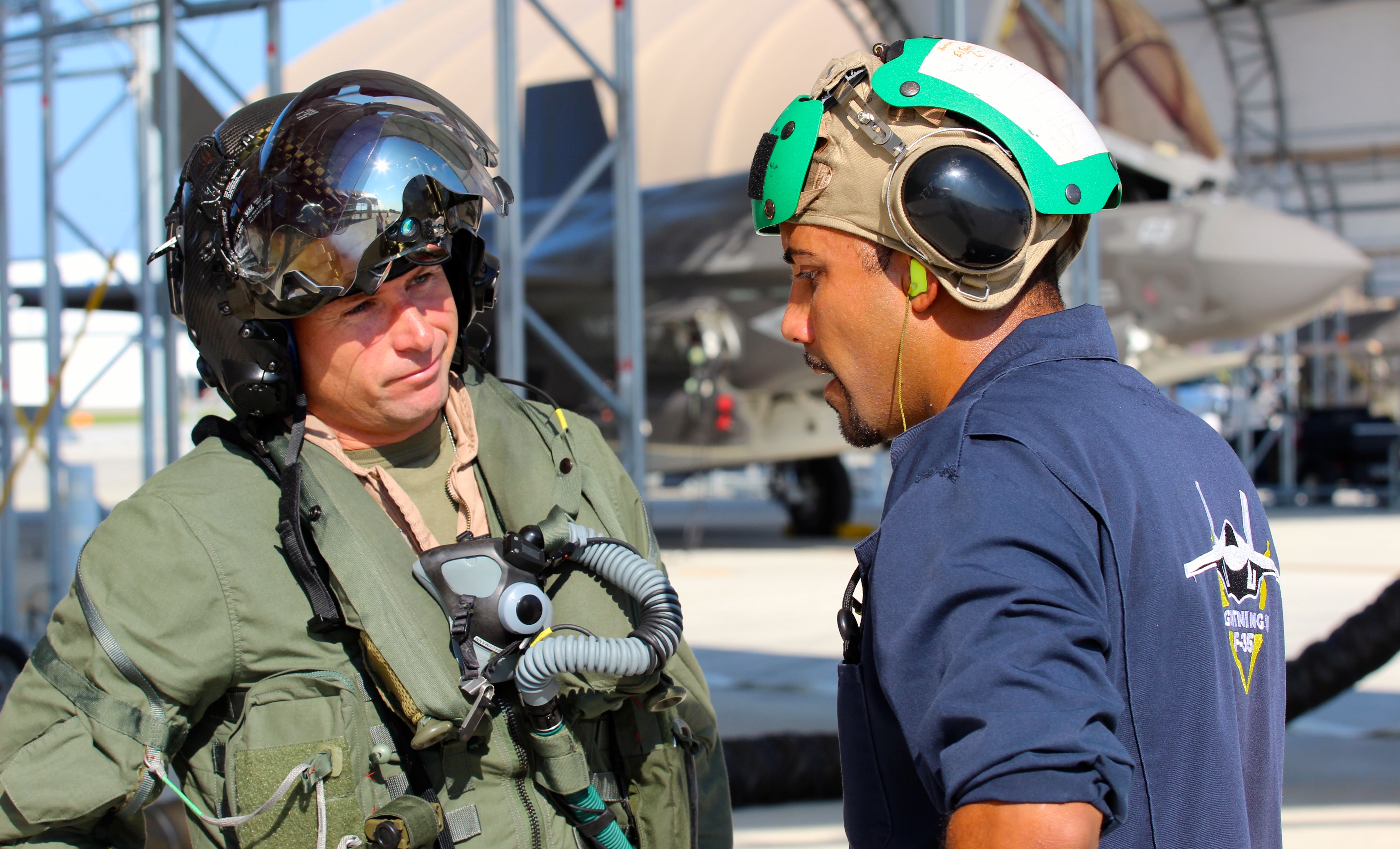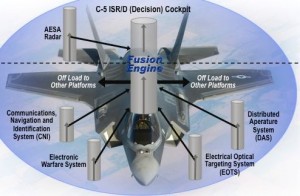2012-11-30 by Robbin Laird
Ed Timperlake has pioneered work on how to understand the entire approach to re-thinking what the new generation of combat air is really all about. To capture the difference between his generation of aircraft and the F-35, Timperlake has focused on what he calls the Z-axis and the fusion engine.
The design characteristics blended together prior to F-35 have been constantly improving range, payload (improved by system/and weapons carried), maneuverability (measured by P Sub s), useful speed, and range (modified by VSTOL–a plus factor).
The F-35 is also designed with inherent survivability factors; first, redundancy and hardening and then stealth. Stealth is usually seen as the 5th Gen improvement. But reducing the F-35 to a linear x-y axis improvement or to stealth simply misses the point. The F-35 is now going to take technology into a revolutionary three-dimensional situational awareness capability.
This capability establishes a new vector for TacAir aircraft design.
This can be measured on a “Z” axis.
Traditionally, the two dimensional depiction is that the x-axis is time and the y-axis is performance and captures individual airplanes that tend to cluster in generation improvement. Each aircraft clustered in a “generation” is a combination of improvements. Essentially, the aeronautical design “art” of blending together ever improving and evolving technology eventually creates improvements in a linear fashion.
The F-35 is not a linear performance enhancement over legacy or fourth generation fighter aircraft. When one considers information and the speed at which it can be collected, fused, presented and acted upon in the combat environment, those who possess this advanced decision capability will be clearly advantaged.
While this is not a new concept having been originally conceived in the famous Boyd “OODA” loop, the information dimension of combat aircraft design now is so important that it forces us to gauge the value of such a weapon system along a third dimension, the “Z” axis.
The Z axis is the pilot’s cockpit “OODA” loop axis or his ability to observe, orient, decide and act. This ability is measured as the combined capability the pilot gains from integrated command, control, communications, computers, intelligence, surveillance, reconnaissance and his resultant decision-making and employment or action.
From Boyd’s theory, we know that victory in the air or for that matter anywhere in combat is dependent on the speed and accuracy of the combatant to make a decision. The better supported the pilot in a combat aircraft is by his information systems, the better the combat engagement outcome. The advantage goes to the better information enabled. Pilots have always known this was true but the revolutionary advancement 5th Generation, designed in C4ISR-D requires a similar advancement in how pilots approach their work.
In addition, today‘s industrial learning curve to improve sensors, system capability and weapons carried is likely flatter than that required to build another airframe and may be a new American way of industrial surging. The American arsenal of democracy may be shifting from an industrial production line to a clean room and a computer lab as key shapers of competitive advantage. This progress can be best seen in movement out the Z-axis.
http://www.ndu.edu/press/the-f-35.html
Shaping a New Approach to Combat Learning
Ed Timperlake has been expanding his research to shape an understanding of how the new pilot culture might emerge with a fleet of Z axis airplanes interacting with themselves and shaping a whole new approach to combat learning.
Our recent trip to MAWTS to discuss the USMC approach to leveraging the F-35 in re-shaping the combat approach of the MAGTF was an important input to Timberlake’s work on combat learning associated with the new plane.
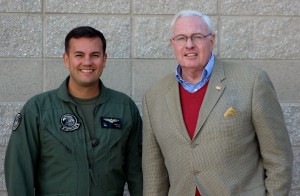
And our discussions with MAWTS focused in part on shifting away from C5ISR as the definer of change in the cockpit to C2 and Information Warfare as the means to describe the approach to the pilot and their culture to working with the MAGTF.
As “Boo Boo” Weber, the head of Tac Air at MAWTS put it:
There’s no doubt that initially when we start talking about the syllabus of the communities that are primarily going to feed into the JSF that you will see change.
You have the fighter attack syllabus and the attack syllabus for the F-18 community and then in the AV8 community. And you need that because you definitely need the pointy-nose guy out there. You’re going to have a high-end platform, fifth generation aircraft that’s going to have some capabilities that are unmatched.
And there’s really only one type of individual that can take advantage of that. That’s somebody from the fighter and/or the attack community.
But there’s some other considerations as well when discussing the F-35.
It is a C2 and Information Warfare aircraft. Our best operators in this world are from the Prowler community, and they are key to shaping the F-35 culture.
For the Marines, such integration is crucial.
We are naval officers, we are Marine Corps officers, but above all we are MAGTF officers.
Which means that once you become a bit more mature, you have to start thinking about not just airspace or battlefields but battle-space. In other words, it’s important that the individual that’s building the syllabus for the F-35 thinks about command-and-control.
Whether you call it cyberspace or information warfare or pushing the right pieces of information to the right places, the F-35 is a centerpiece for Marine Corps thinking about the future.
In other words, you don’t want to put people in charge of training, creating training syllabi, or essentially, creating tactics that are thinking simply at the air operations level. You have to think about this holistically from the MAGTF perspective and not just operationally from the air or from the air for the air.
We have to think operationally from the air for all the other elements of the MAGTF.
https://sldinfo.com/mawts-and-the-yuma-f-35-squadron-evolving-capability-into-operational-reality/
Rethinking the OODA Loop
Based on this an other discussions we had at MAWTS, Ed Timperlake has re-set his thinking about how to best proceed in understanding the combat learning revolution associated with the F-35.
In May of 1981, Ed Timperlake published “A Methodology for Estimating Comparative Aircrew Proficiency” for The Theater Forces Division, Office of Strategic Research CIA.
Col John Boyd USAF (ret) was very helpful and instrumental in providing insights into how to evaluate both aircraft technology, and a nations tactics, training and combat proficiency. Measuring the ever-evolving aircraft maneuvering energy capability Boyd’s emphasis on P sub S energy maneuverability performance curves were seminal.
Adding his OODA loop formula to technology was a brilliant insight in merging technology, training and tactics. This period of TacAir development was in a never ending quest to quest to always achieve “SA”–Situational Awareness.
Because of the technology limitations of then Command and Control battle management the focus was focus was appropriately on building a better “Observe Orient” half of his “formula” (AWACS is an example).
With the F-35 Cockpit Z-axis the key words are actually now embedded in the second half of his OODA –the words “decide, act.”
The quest for US way of war to always fight and win is to now embrace the entire spectrum of Boyd’s OODA by not questing for Situational Awareness, because that is only half way but rather everything should be now focused on developing technology, training tactics and C&C at all levels to empower “Situational Decisions.”
This is the true revolutionary step beyond just SA that the “z-axis” F-35 Fusion engine brings to the fight as a catalyst for a 21st Century refocused way of support equipping and training all Service joint con-ops.
The research continues with the above insight into rethinking the OODA loop.
Timperlake adds:
I have been trying to formulate a way to expresses the human/machine evolving action/reaction cycle understanding that everything is always relative. “Beef” (an Air Command and Control Officer) gave me the insight I needed to complete a year’s worth of research on ways to look at this dynamic.
Based on our discussions with Dean Ebert, (NGCO employee and former USMC EA-6 driver) I have been focused on the combat learning cycle associated with the new cockpit, the sensors in the aircraft and fusion prospects.
I seized on an MIT concept of the “engagement process of content” to understood how learning evolves. Similar to some of the thinking of Piaget, that one’s ability to learn evolves over time with age and learning, we now need to understand that learning in the cockpit powered by the fusion engine is not simply a linear repetitive experience. It is a learning experience and is done so within the fleet, both flying, just returned and about to engage.
In our very robust discussion with “Beef,” he added “in context” to the statement and clarified the approach. We are now not talking about Situational Awareness as the key dynamic but Situational Decisions.
A foundation for “fifth generation” operations realize is built around the notion of learning rapidly in a combat situation and acting on that knowledge.
The engagement process of content in context empowers dynamic situational decisions at all levels and gives the fighting force the best chance of prevailing.
The “engagement process of content in battle context” which empowers dynamic situational decision making at all levels has the best chance of prevailing. It is the foundation of war winning in the 21st century.
And the discussion with “Beef” highlighted an important clarification in another sense. Instead of confusing folks with C5ISR and with situational awareness, we should focus on C2 plus information war. Pilots in the F-35 are Information Warriors. A fleet of F-35s puts in the air with a 360 degree swath a decision and information warfare grid. This grid is leveraged throughout the battlespace for ground and surface operations throughout the engagement.
Adding “Beef” to MAWTS a 7202 –and going back to using the term “Information War” (I used that term in Red Dragon Rising published in 1999) actually brings more clarity than just “cyber” which is a critical subset. Additionally going back to C&C is equally important -C5ISD just does not add much–getting to too cute.
Skaff and Timperlake Discuss Future Evolution of Combat Learning
When Ed and I visited the Fort Worth plant of the F-35 program, we had a chance to continue the discussion with Mike Skaff, one of the legendary designers of pilot interfaces for cockpits. His work was seminal for the F-16 and foundational for the F-35. The dialogue between Skaff and Timperlake – between a former F-16 and F-4 pilot – provided context to understanding the transition in pilot culture.
Question: When we visited MAWTS, they underscored that the experience of Prowler pilots was crucial to shaping the new IW and C2 pilot culture for the F-35. They are positioning themselves to live the new Z axis culture and to shape future requirements for the evolution of the plane as a combat system.
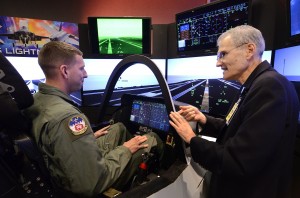
Skaff: The Z axis and the fusion engine graphic captures the essence of the change, or the foundation from which change will occur.
It points out the advent of the information age.
We’re old enough, and we can remember when there weren’t cell phones. There was a time when there wasn’t an Internet. We can remember that distinctly.
When these tools show up in the early ’90s, there’s a paradigm shift that we call ‘the information age’, and now it arrives in the airplane. With the F-35 we enter into the information age in a new way and we can connect these airplanes just like nodes of the Internet. I’m not saying we’re connected to the Internet, but it is like that. I like to think of this as information dominance. When a 5th generation fighter arrives in battle space the pilot has information dominance. The F-35 was specifically designed to provide the pilot with information dominance through multi-spectral, multi-sensor, distributed processing and advanced fusion – this is the distinction and the difference from the 4th generation. This is the paradigm shift.
Because this is software-defined plane built around evolution over time, we know the future is going to be different. The threats will evolve and everything else.
But initially, these initial airplanes have all of the hardware in place to last for a couple of software upgrades. And so, we can redefine the airplane in its missions and how the sensors work and what they detect. Hypersonic cruise missiles, seeing that the horizon maybe with DAS, who knows what is the next evolution, but we know it is coming. And the plane is built to anticipate change.
Recently a Marine Corps general underscored that we are not making this airplane for Harrier pilots.
In fact, most F-35 pilots haven’t been born yet.
You’re making it for the next generation. And they’re going to jump into the cockpit and they’re going to see a Nintendo or a PlayStation or whatever is the deal at that time.
But they’re not like us old guys that are looking for air speed, altitude, conventional electro-mechanical gauges. They literally see a video console in front of them, and we’ve got to make the airplane for them. They can deal with information and they can process it differently than you and I can.
Question: Currently we try to achieve such dominance with a fleet of specialized air and related assets. What will be the impact of doing so with a core fleet of interactive Z axis airplanes?
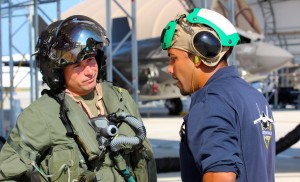
Skaff: It is about survivability in an information dominance environment. By reducing the gaggle of aircraft to an interactive air system with other combat assets, we can pursue air dominance against a reactive enemy. It will be a different paradigm leveraging the Z axis to pursue information dominance.
Question: And the fact that the US will be flying a plane similar to its allies and able to share information across the battlespace will be important as well. How do you look at information sharing across a coalition fleet of Z-axis airplanes?
Skaff: Now we can get airborne in a coalition and we have all of the synergy of deployed combat fleet. We can’t go wars all by ourselves anymore, we want our allies to be there with us and share the burden and share the costs, share the risks, and now we can do that extremely well with the global F-35 fleet.
Timperlake: Mike, we came up through the generation of always trying to achieve SA, situational awareness. That was the nature of my fighter squadron and your your squadron, too.
I think now with the F-35 cockpit, you’ve moved to a different level, a paradigm shift of situational decision making with information available across the fleet even to the youngest aviator.
They have situational awareness, but it takes it to a different dimension, it takes it to situational decision making in the context of the particular environment they’re in.
And that, I think, is a revolution, which makes it an action item as just opposed to an awareness item. You can use information as a weapon. You can use kinetics, and the machine/man interface will allow an evolving battle management fleet to address current and near-term threats.
Are we entering a new era of deterrents and airborne situational decision making?
Skaff: Yes, and I think we can relate it to our experiences.
As a young blue 4 wingman, I had no clue what was going on. For 300 hours, they drug me up and down the East Coast. I could fly formation, but I couldn’t do much else. In fact, I wasn’t sure I’d ever figure this out; it was so complicated in an F-16. And now, because what you’ve been talking about, blue 4 has the same knowledge as 1 does.
If one gets shot down or has to return to base for some reason, two has the knowledge one has and can just take over.
This is the value of distributed information.
Timperlake: So, we have a constant sorting of consistent information.
Skaff: That is right.
Timperlake: This is why the real testers are the pilots. The actual testing of this Z access F-35 cockpit fusion engine revolution rests with the pilot and the operators and not the test community.
Skaff: That makes sense.
Timperlake: Let me be clear. The test community does great work in ringing out the airframe and making sure the weapons release and the airplane will be solid and safe.
But the evolution of the Z access and the cockpit revolution can not be tested by someone from a desk running test protocols.
It’s the dynamic learning of a young, middle and senior aviator feeding it back to the engineers and learning the capability of the brand new step generation or paradigm shift of this cockpit.
Is that a fair statement on putting the test community in perspective?
Skaff: I think so.
MAWTS, NSWC, and the Air Force Fighter Weapons School are able to explore that Z access and find out just what that does they are the real testers.


